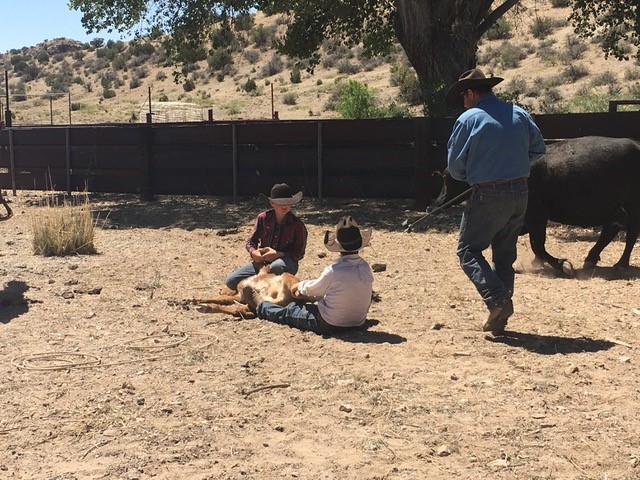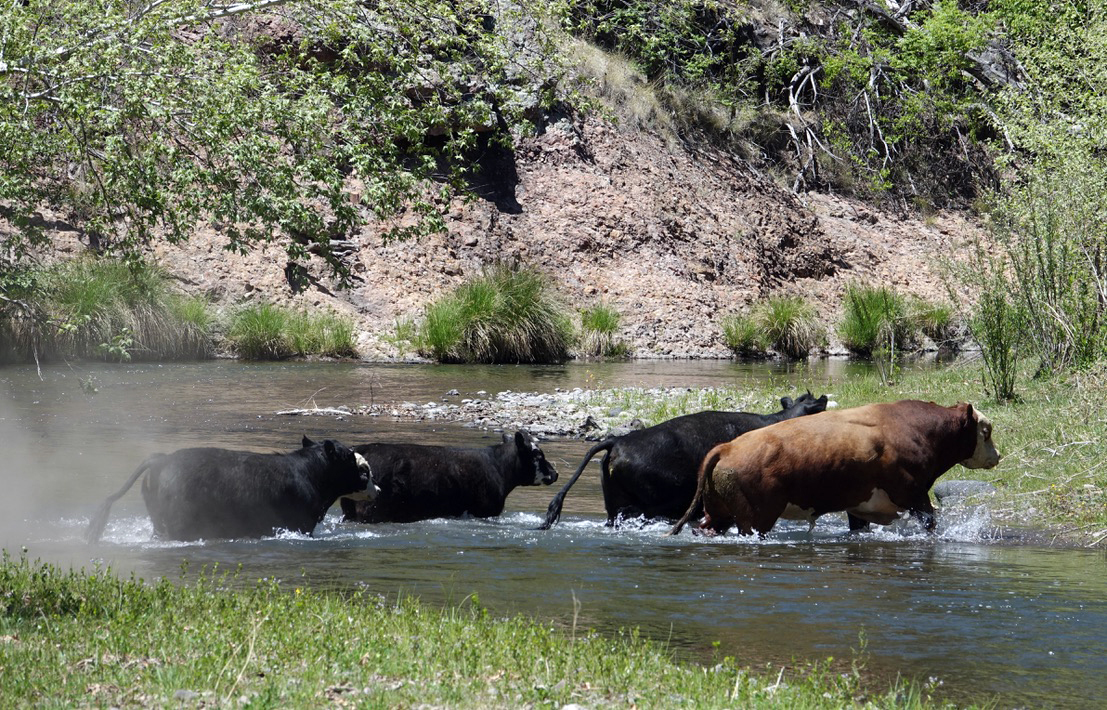Grass-Fed and Grass-Finished Beef
We avoid referring to ourselves as “ranchers,” rather we prefer “ranch owners” because there is a clear difference between a “cowman” and retirees using a historic cattle ranch for restoration, wildlife and carbon sequestration. Our goal is to encourage others to do the same. This is fundamentally a “restoration ranch” or demonstration project in hopes of not only restoring and promoting healthy habitat but of showing others how easy this is and how everyone can adopt these restoration practices on land of any size.
That said, we have run as many as 40 head and as few as four. There is a good deal to be said about grass fed and grass finished cattle. Unlike stockyard or feedlot cattle, grass-fed cows that live on the range — without hormones or growth-promoting additives — and eat only grass grown there provide beef that is different. Compared with feedlot beef, meat from grass-fed cattle has less total fat, saturated fat, cholesterol, and calories. It also has more vitamin E, beta-carotene, vitamin C, and a number of health-promoting fats, including omega-3 fatty acids and conjugated linoleic acids. They are stress free and free roaming. While cattle are unavoidably hard on the land, when few in number and rotated regularly, the damage is minimized.
In keeping with recognition of climate change, we are working to see that our herd is all white. Recent studies have shown that white cattle run 15 percent cooler than black cows and, with increasing temperatures in the Southwest, this is a sensible adaption. There is even a new, genetically modified breed of “White-Black Angus." Ranchers know that heat stress during summer negatively affects animal performance. Cattle instinctively will use natural shade to escape the radiant heat from the sun. Associate Professor M. Shane Gadberry of the University of Arkansas writes, “Breed type and coat color can influence heat tolerance.”
C.R. Dahlen, Beef Cattle Specialist, and C.L. Stoltenow, veterinarian, write, “Animals with dark hides are at a higher risk of suffering heat stress and dying.” A 1999 Mississippi State University of Veterinary Medicine study found that black cows may absorb more than twice the solar radiation than white cows; another study found that cows with white hair coat absorb about 66 percent of shortwave radiation compared to 89 percent absorption for predominately black-hair coat colors and still others suggest that white cows are 15 degrees cooler that black cattle.



United States Scientists Dr. James West and Dr. Warren Gill have announced they will have a white Angus close to a commercial reality that will produce white calves — with a “far greater heat tolerance capacity” — by early 2017. A startup in the U.S. called AgGenetics is using modern biotechnology techniques developed for human medicine to remedy the heat absorption shortcomings of the traditional Black Angus. This company states that its new technology is protected by more than two dozen patent applications that will allow the replacement of the black coat normally found in Angus cattle with white-hair coat colors and add approximately 15 degrees of heat tolerance in Angus. We now have a registered Charolais bull and the cows are all white, so we no longer have any dark coated cattle.
We are unlikely to commit to the expense of a white Angus bull because our herd is so small, but it does confirm that narrowing the herd to Charolais will be helpful. The change will be one of the many kinds of adjustments we’ll all be making to adapt to this new normal of the ever hotter and dryer planet.
Helpful Neighbors
Our neighbors at the Thorn Ranch or AT-Cross help us with branding and band-castration. We no longer inoculate, working with the National Resource Conservation Service program to bring back the Dung Beetle to its earlier numbers. Pictured here is Wayne Billings and his sons, Justin and Carson. Oscar Peña and Dave Jones of the Thorn Ranch have helped often.
Since retiring here, we’ve learned that being a “good neighbor” is almost as important as water. Our neighbors are willing to step up whenever asked. As outsiders, city people, not real ranchers, not New Mexicans, we were understandably hesitant about how we would be received, an unwarranted worry.

Water-Tank Escape Ramps
Whenever people move into rural country or wilderness, wildlife suffers. COVID-19 is a direct response to the spillover of infectious disease as humans continue our encroachment into wilderness. Encroachment into rural, semi-wild open spaces in the Southwest is part and partial of this same crime of humans taking over every finite thing the Earth has to offer.
Despite the historic damage cattle ranching has caused in the Southwest, we remain in support of cattle for two inter-related reasons. When ranchers fail or die without heirs interested in ranching, the land is sold to developers who breakup the property in 40 to 160-acre ranchetts.
Semi-wild places shrink. Agriculture and ranching contribute 17% of the country’s greenhouse gasses and if the world’s cattle were a country, it would be the third largest greenhouse emitter behind China and the United States. Scientist are adamant that a serious reduction in meat and dairy consumption is a must if civilization is going to arrest the climate and species extinction crises. More that 70 percent of all US beef comes from feed lots, only three feed-lot corporations are now marketing almost 60 percent of the cattle fed in the US. Stockyards must go and when they are gone, what little meat we still consume will come from grass fed and grass finished ranch-raised beef. Wildlife corridors will be maintained and free roaming animals will still have open range in which to live.
Ranching and wildlife need to co-exist. Yet even when you ranch responsibly and do your best to take wildlife into account, human presence causes losses. We have lost five mule deer at the headquarters over the past 17-years, one that we discovered with its hind foot caught when jumping over a fence long after it suffered and died, a second with a broken leg caused from jumping a fence that we had to put down. We have also lost three deer to drownings in the large water storage tank or steel-rim near the headquarters.
Drowning in water features for storing and watering cattle had long been a problem before the solution of escape ramps. Even though these do not seem to work for deer (we have lost two deer since installing ramps) they clearly work for all other wildlife, especially hawks.
Escape ramps made of galvanized steel last longest. Although there are a broad range of styles, the three pictured here work best for us. The large one on the left is for deep water steel-rims or storage tanks, the smaller ramps are for smaller, ground level drinkers.
We install three or four ramps in each of our water storage tanks, depending on size.


Smaller water features for drinkers have escape ramps, as pictured here.

Each artificial water feature on the ranch has an escape ramp.

The Gila River’s Feral Cattle
For well over two decades feral cattle have been recking havoc in the main stem of the Gila River. The animals are huge, wild and dangerous.
Although feral cattle are often blamed for the feral cattle problem, of all cattle removed over almost two decades, only one cow carried a brand. Whether they like it or not, ranchers are fulfilling their obligation to keep their cattle off the river. At the same time, I heard a local rancher state in a public meeting that the feral cattle problem existed because recent government policy kept ranchers and their cattle off the public riparian lands. He claimed that if monitored grazing were permitted, the problem would take care of itself. This absurd thinking reflects the abject failure of some cattlemen to accept the fact that cattle trampling prevents riparian areas from maintaining the health necessary to avoid erosion and incising.
Even more preposterous, in the face of the climate and species extinction crises, the Gila Wilderness is keystone habitat and will provide refugia as the Earth continues to overheat. Despite the fires on the West Coast, the storms and flooding on the East Coast, the Gulf Coast disasters year in and year out and the firm scientific data that meat and beef account for 17% of greenhouse gas emissions, this sort of antiquated thinking ignores the trends that will see stockyard fed beef unavailable and range fed and finished cattle at a premium. The climate crisis will lead to a prosperous future for ranchers, but far too many cowmen have dug in their heels and denied the onslaught of the climate and extinction crises that is on track to end civilization as we know it if governments don’t step up.
The Center of Biological Diversity, Plaintiff in the earlier litigation, again initiated legal proceedings in July, 2019, and in September, 2020 correspondence from the United States Department of Agriculture, the Southwest Regional Office of the U.S. Forest Service assured a variety of river loyalists that the government intends to see that the feral cattle are removed, once and for all.

